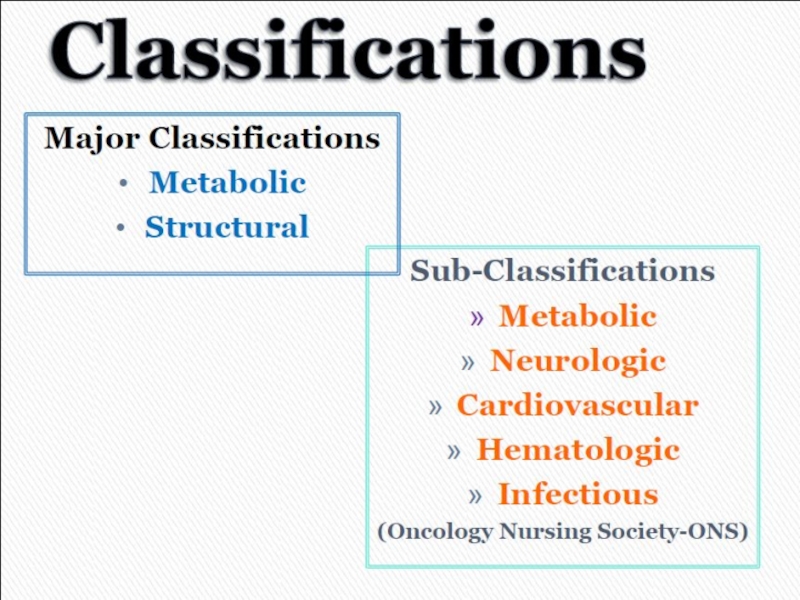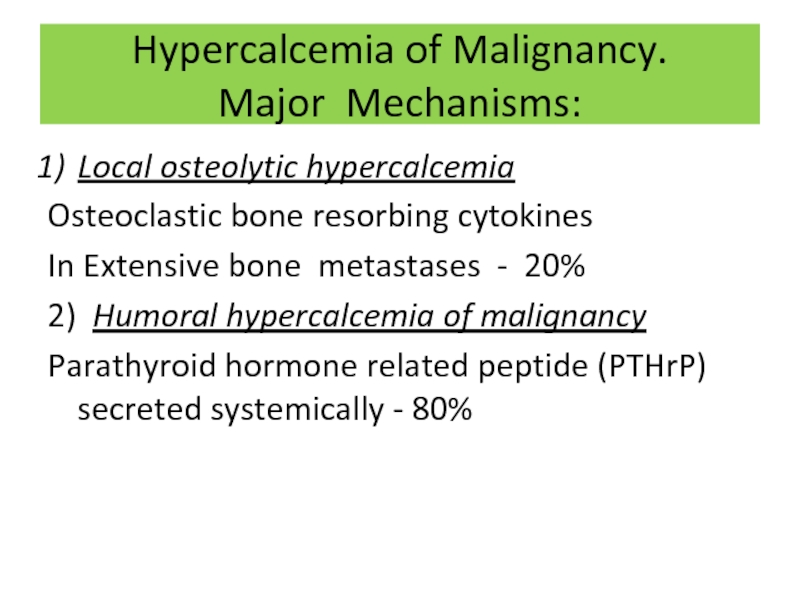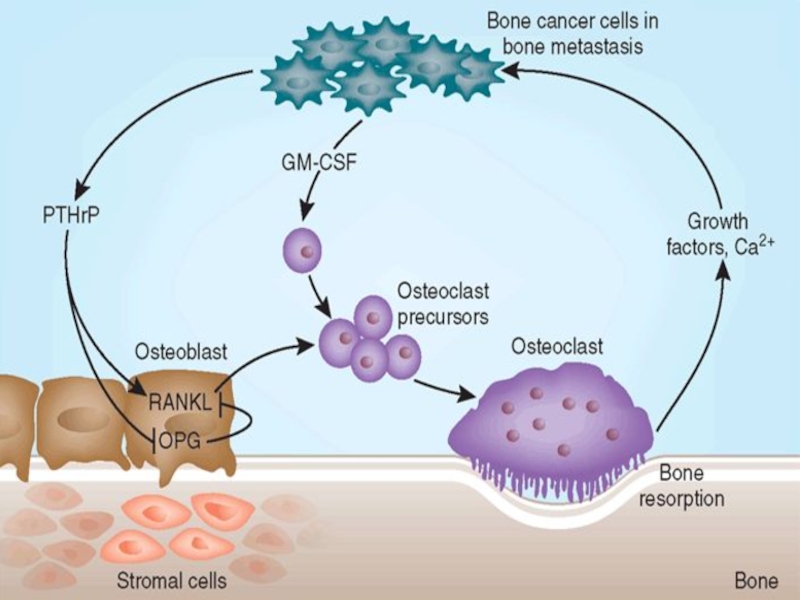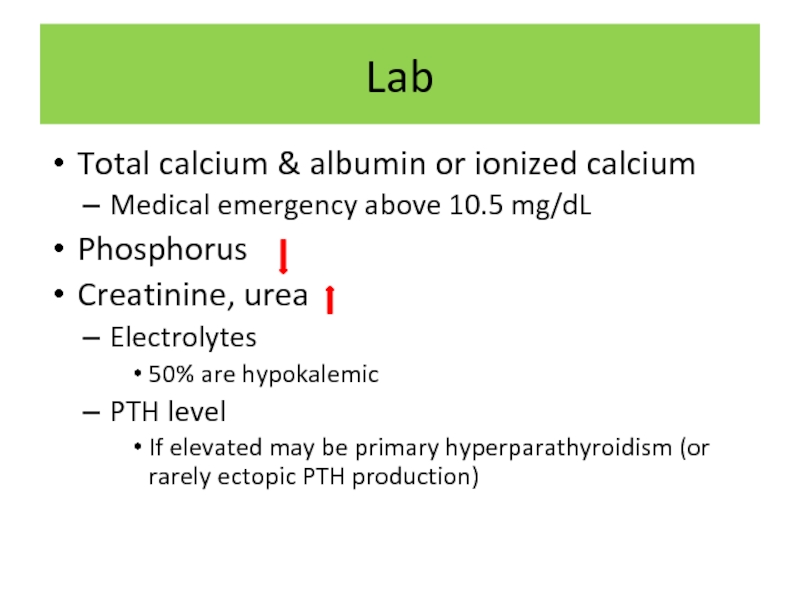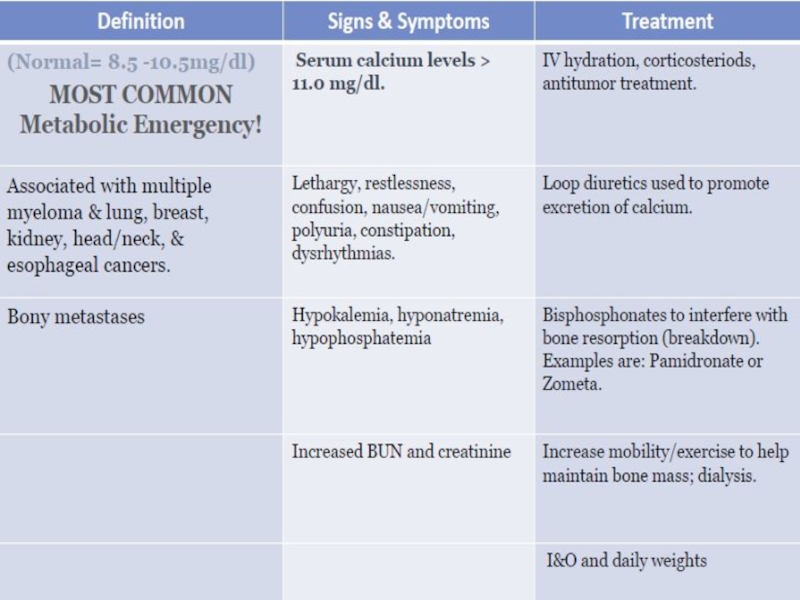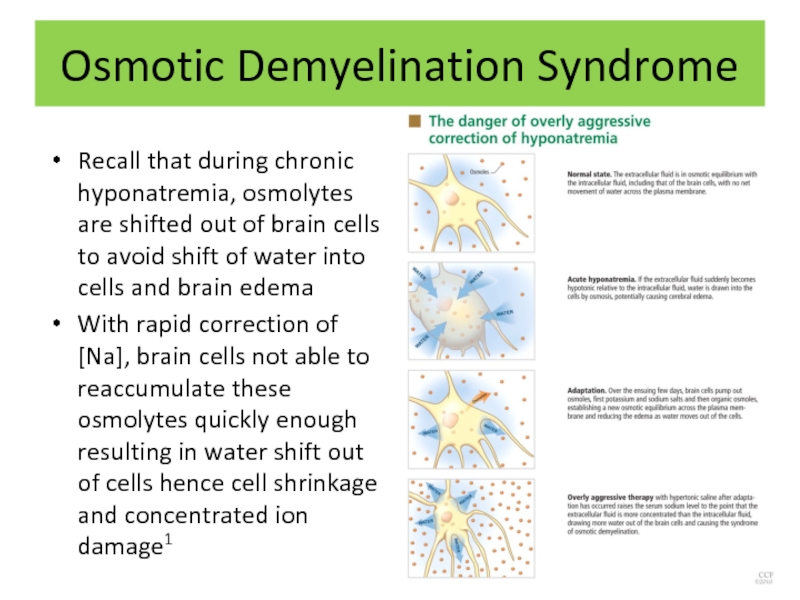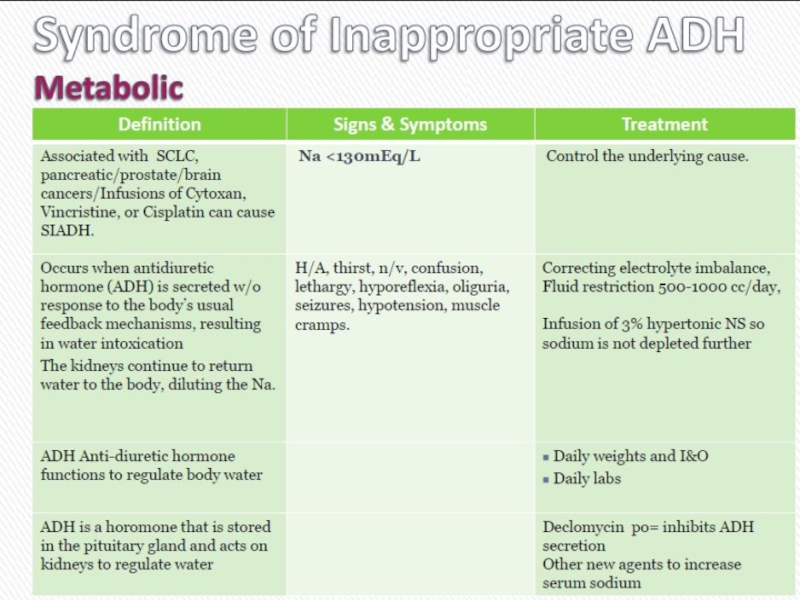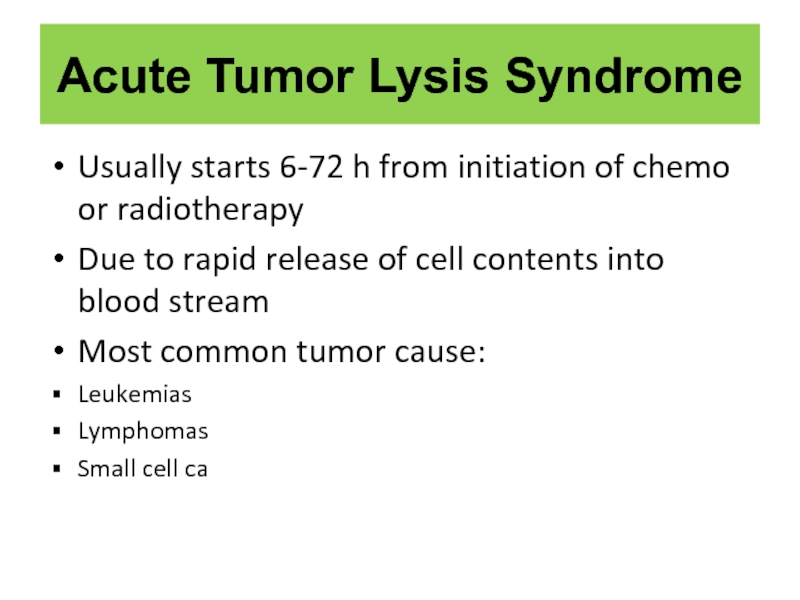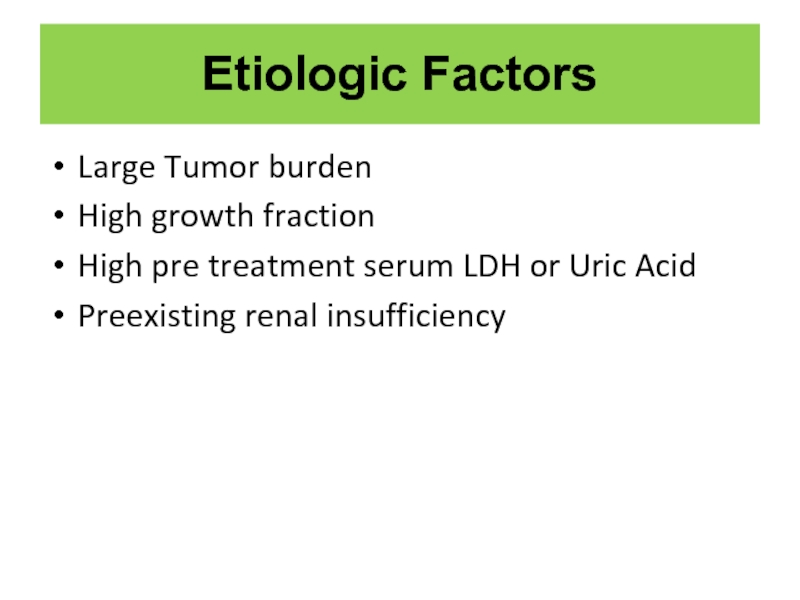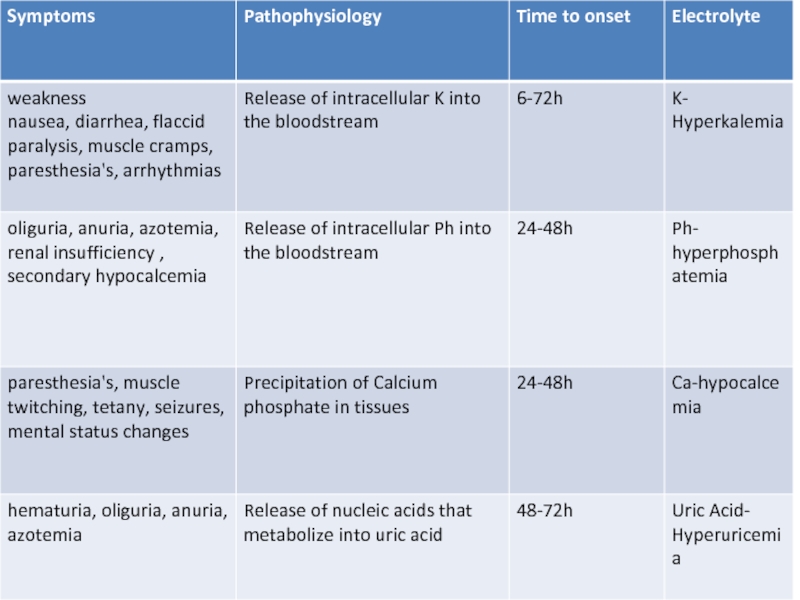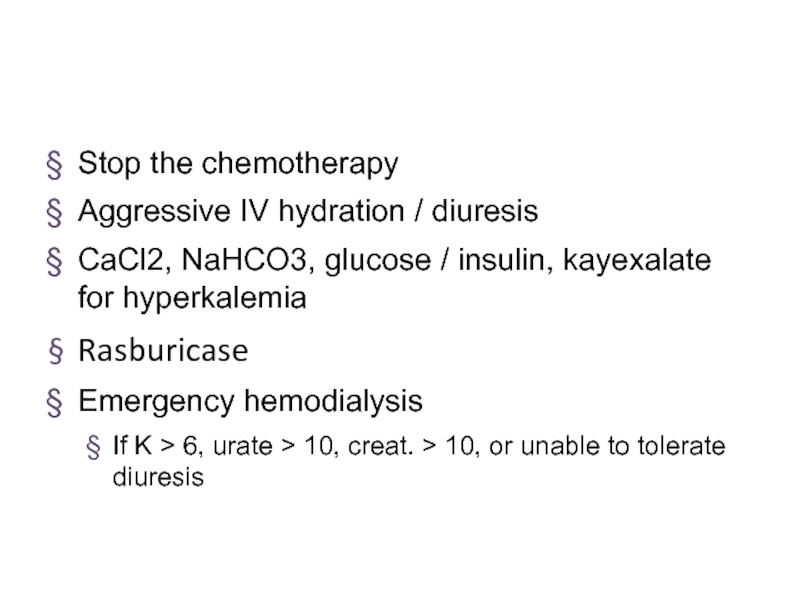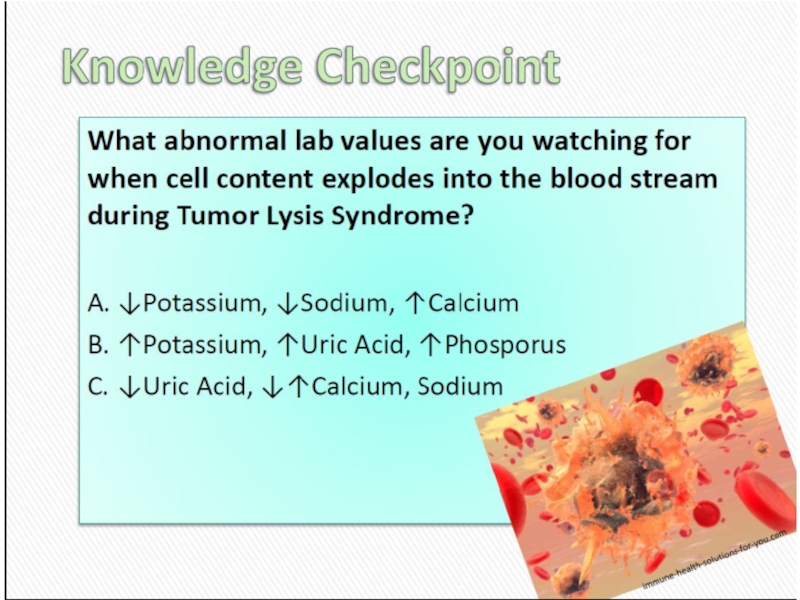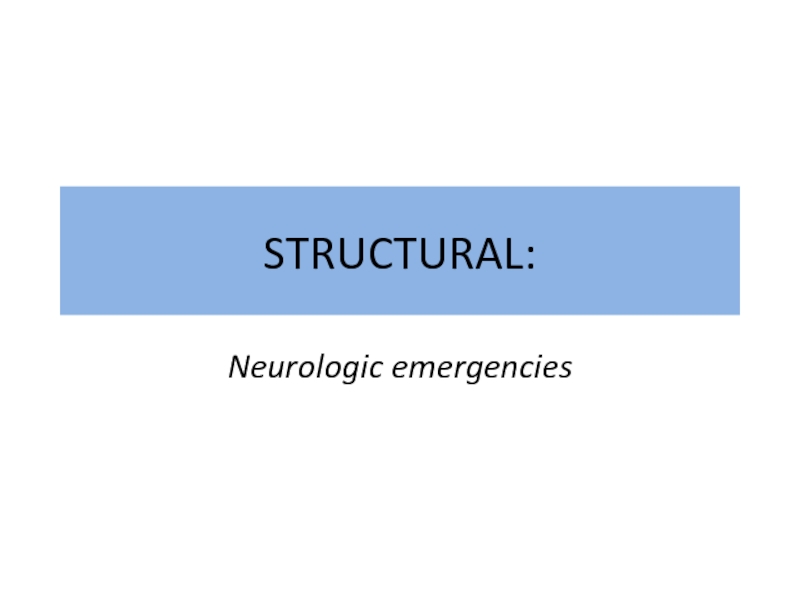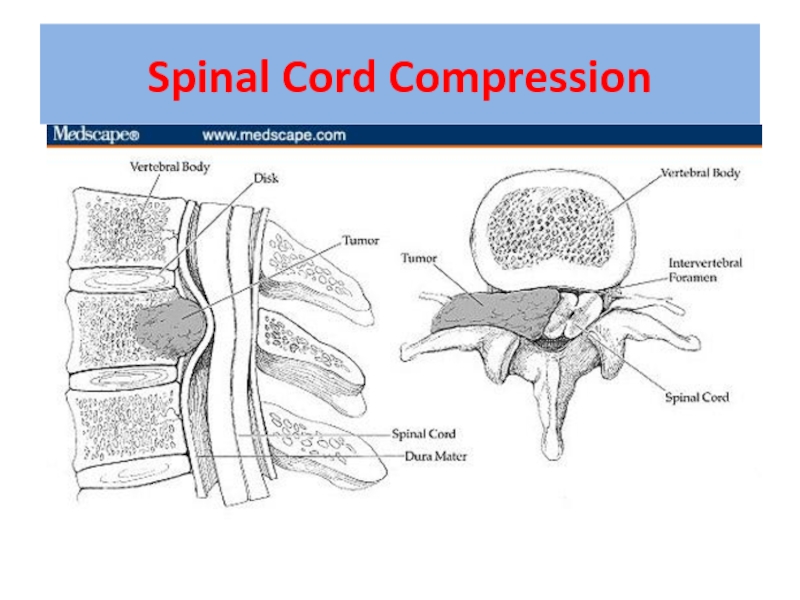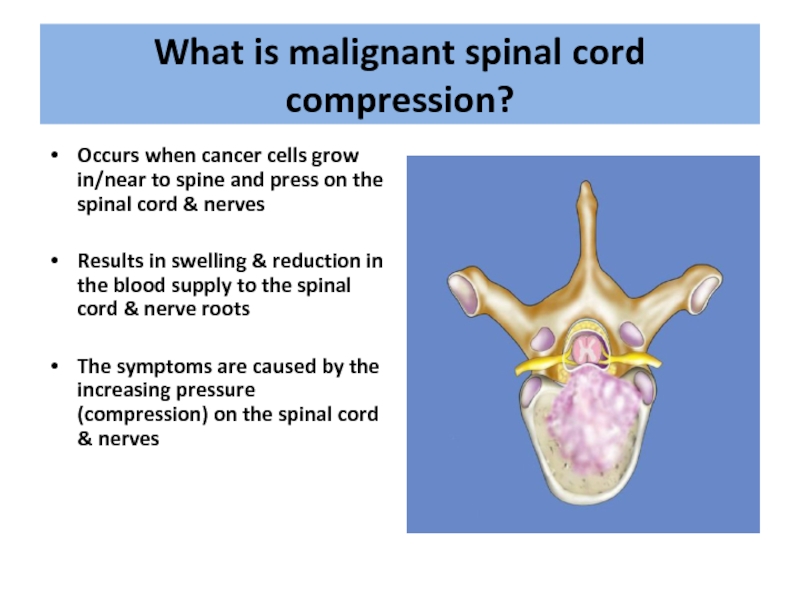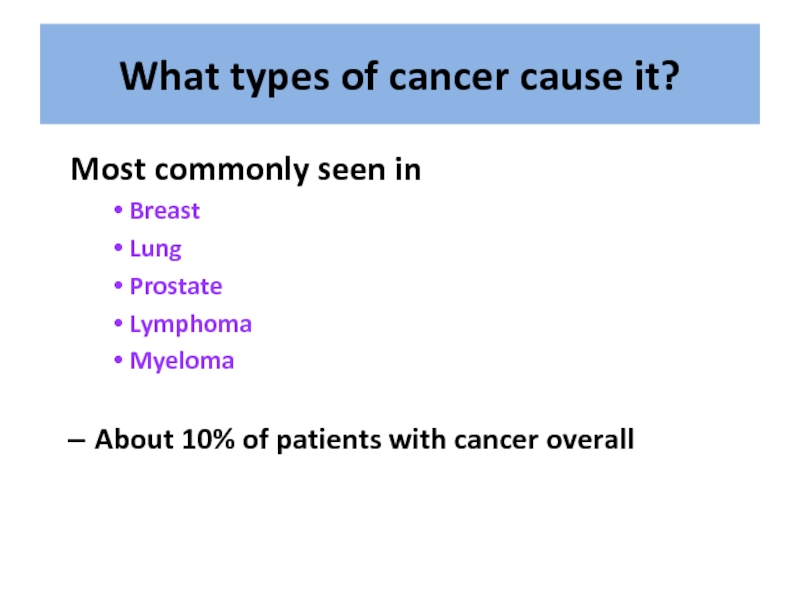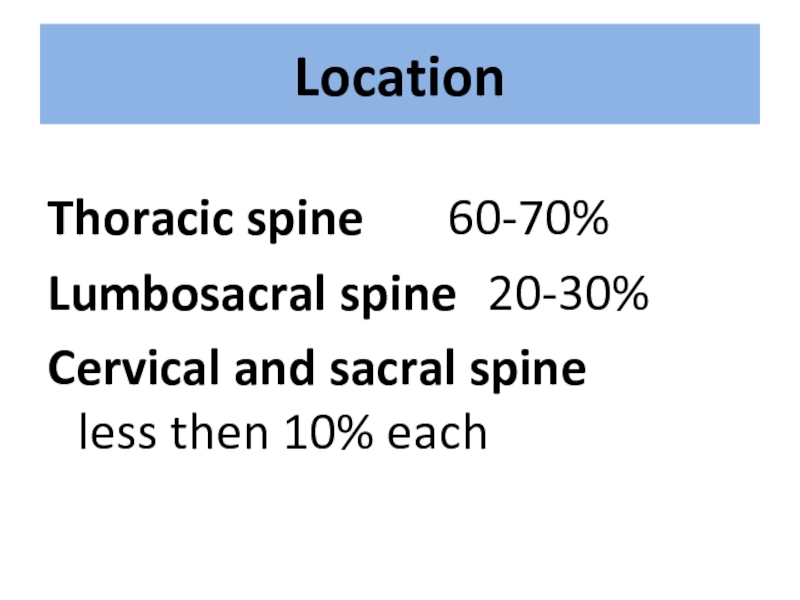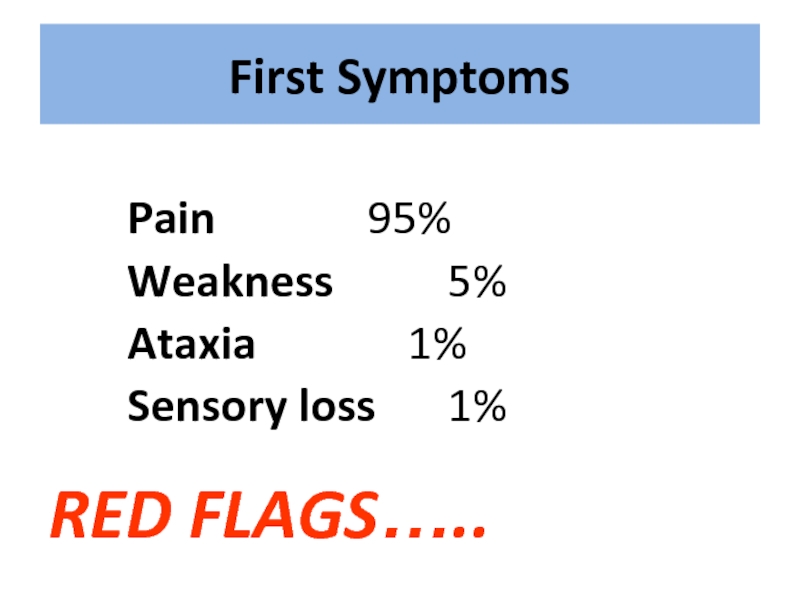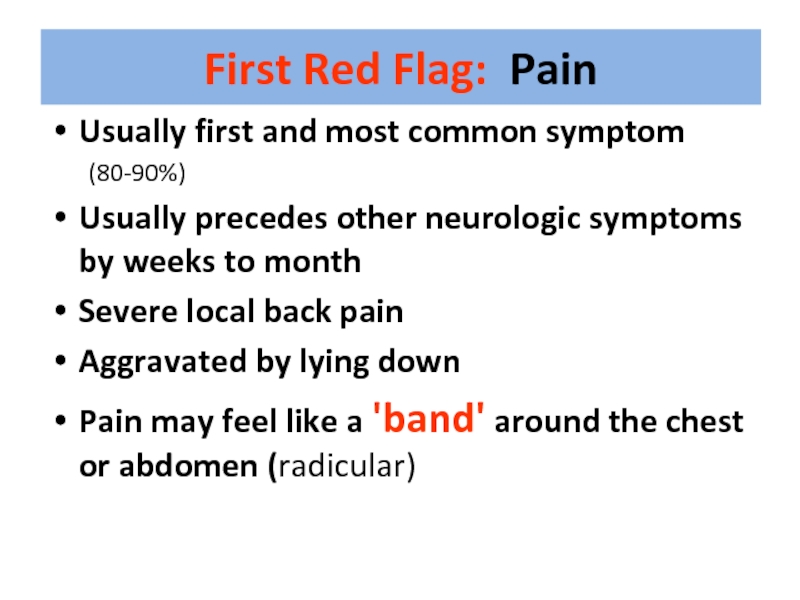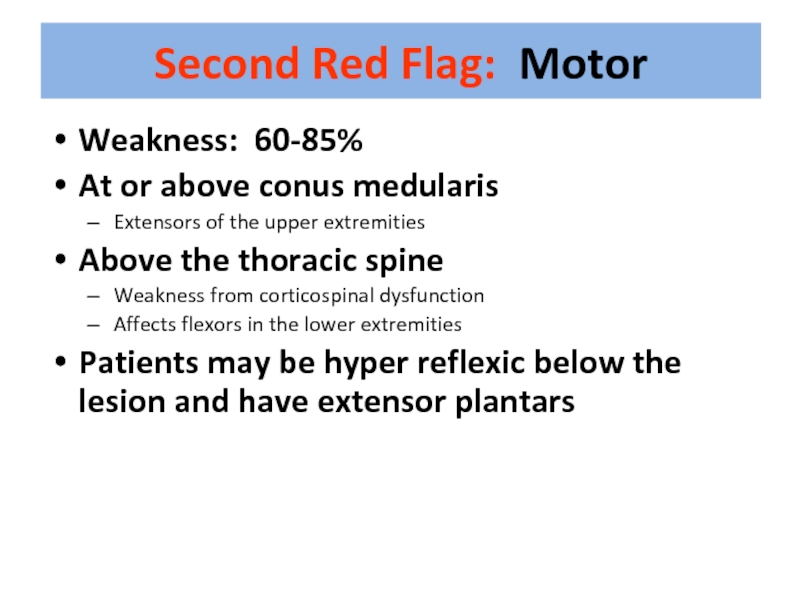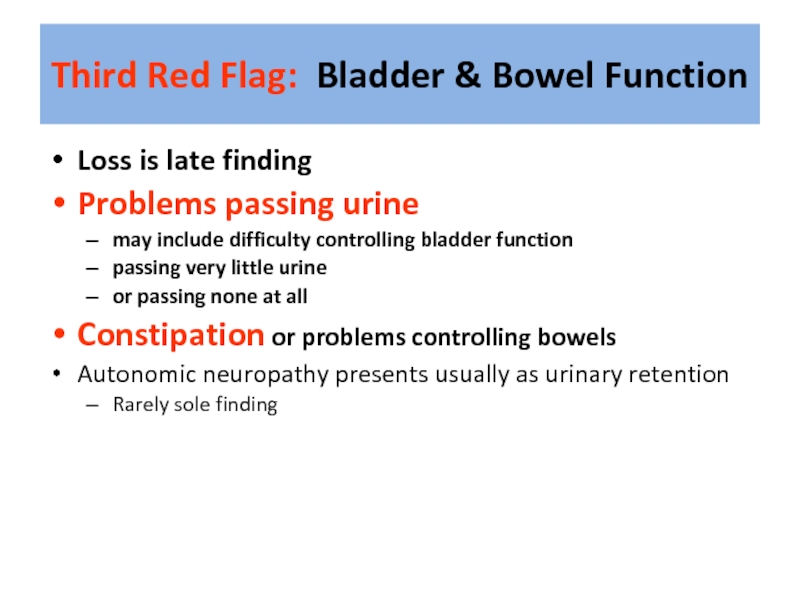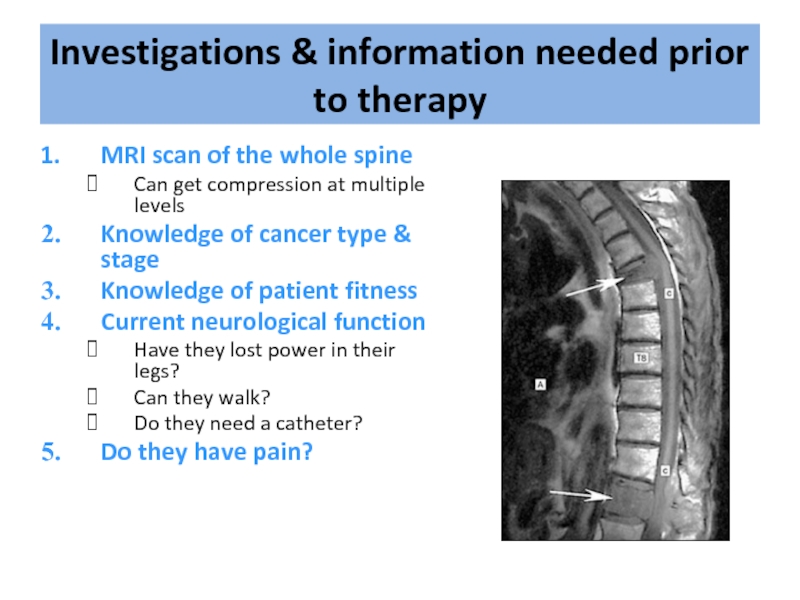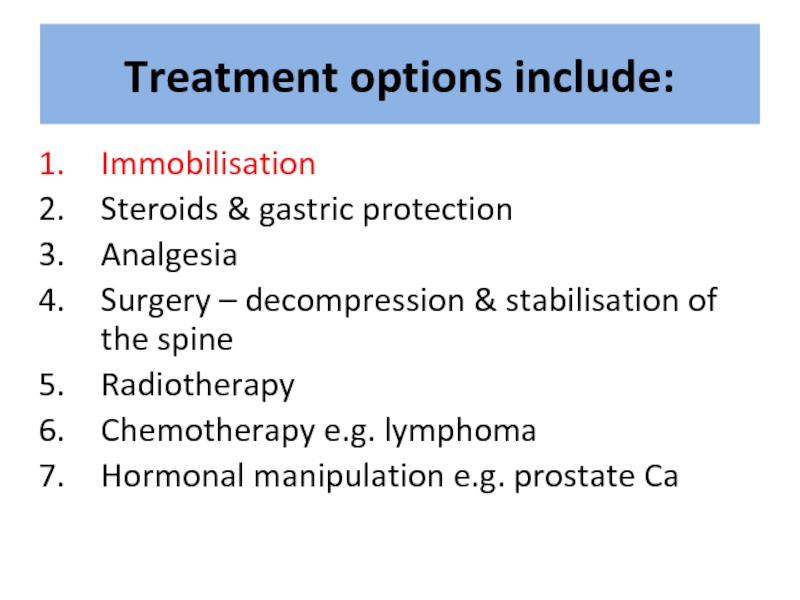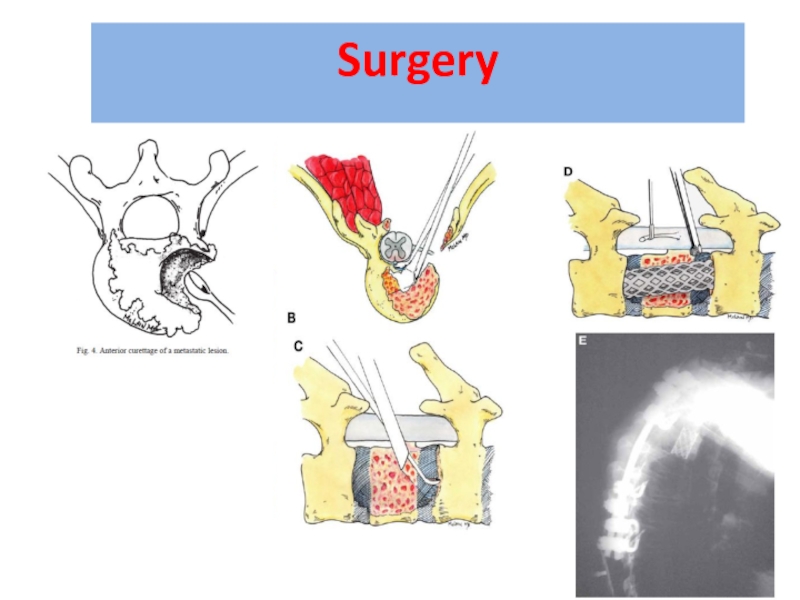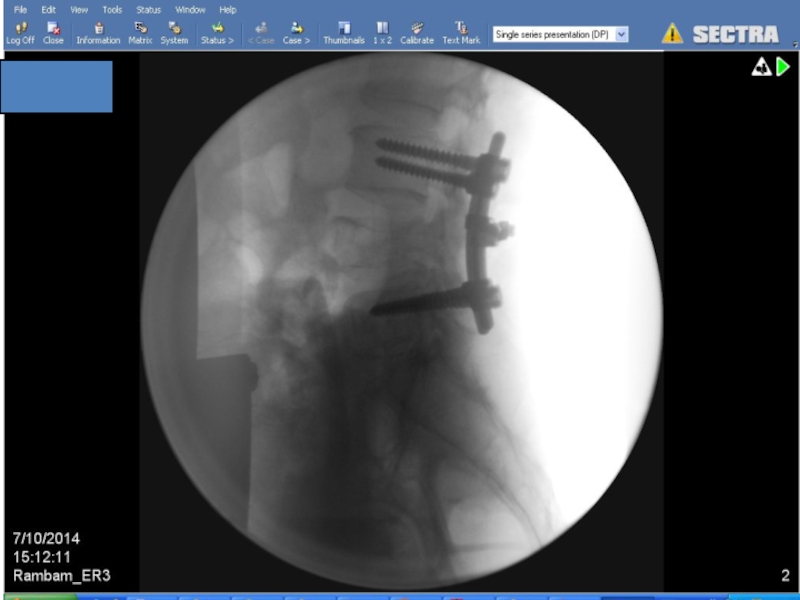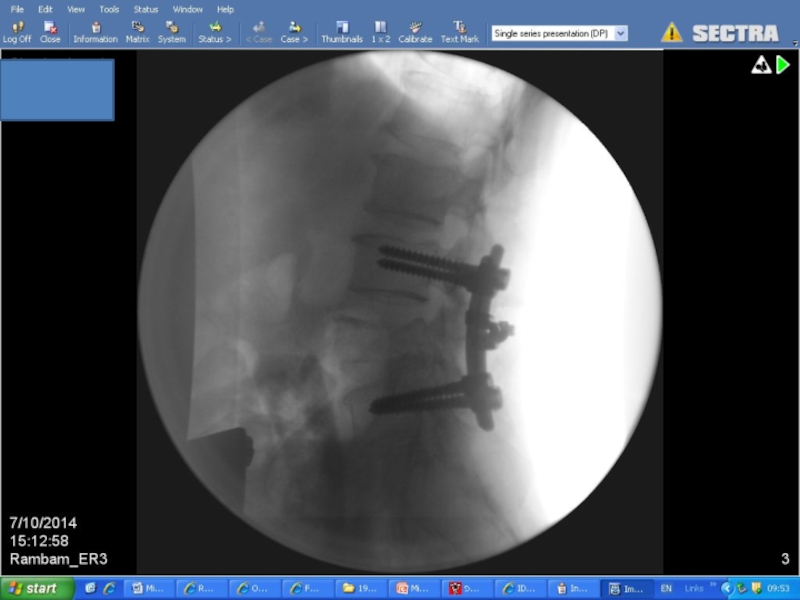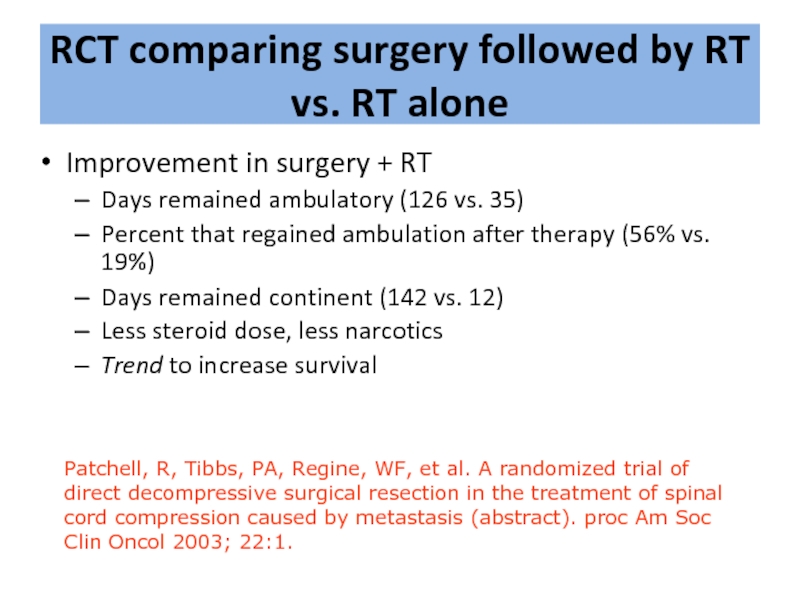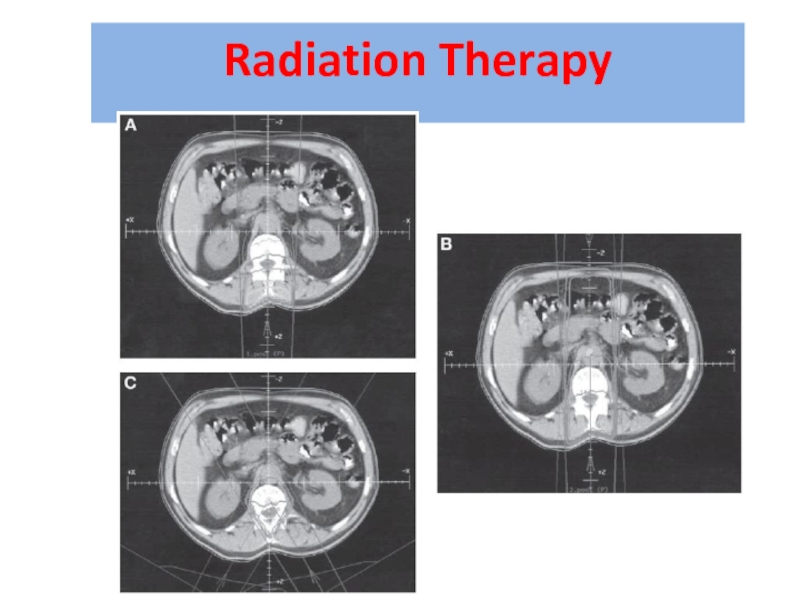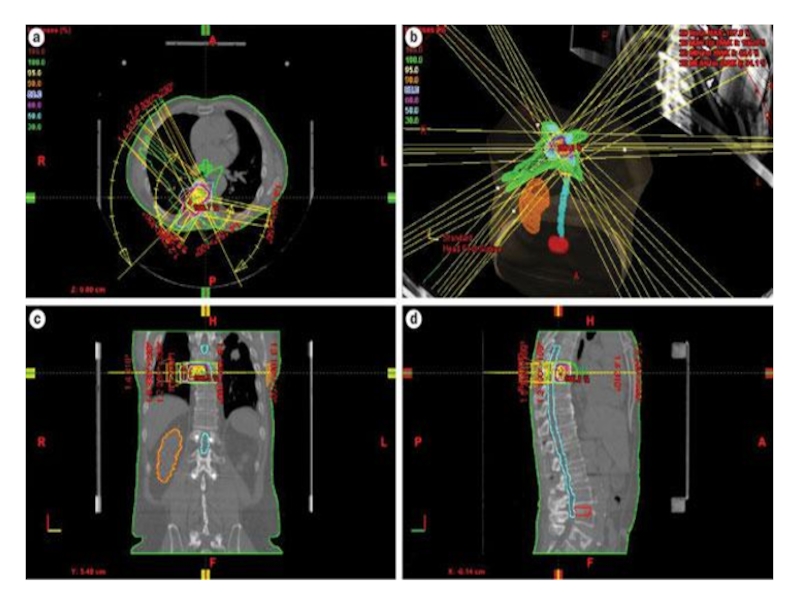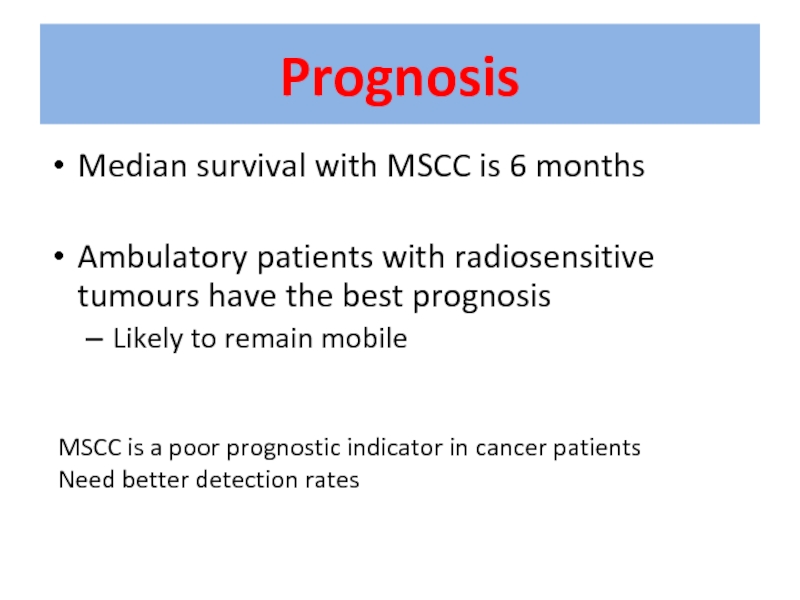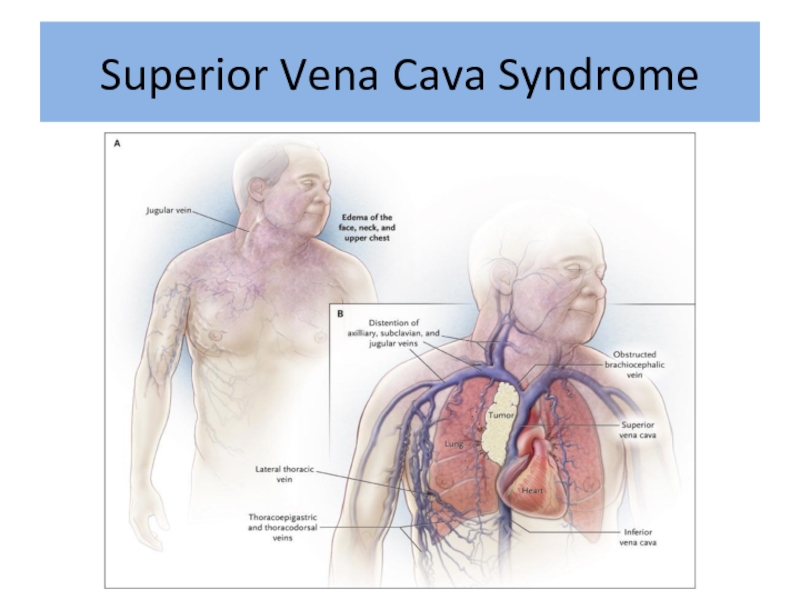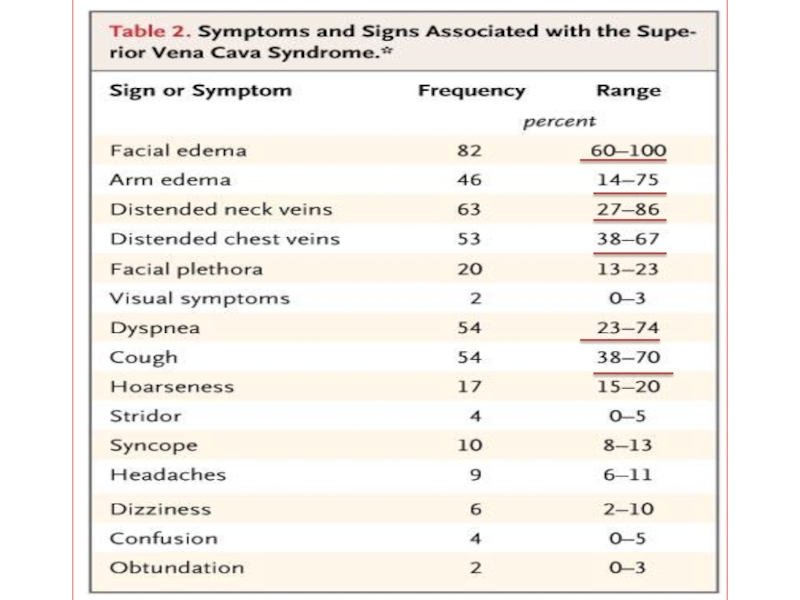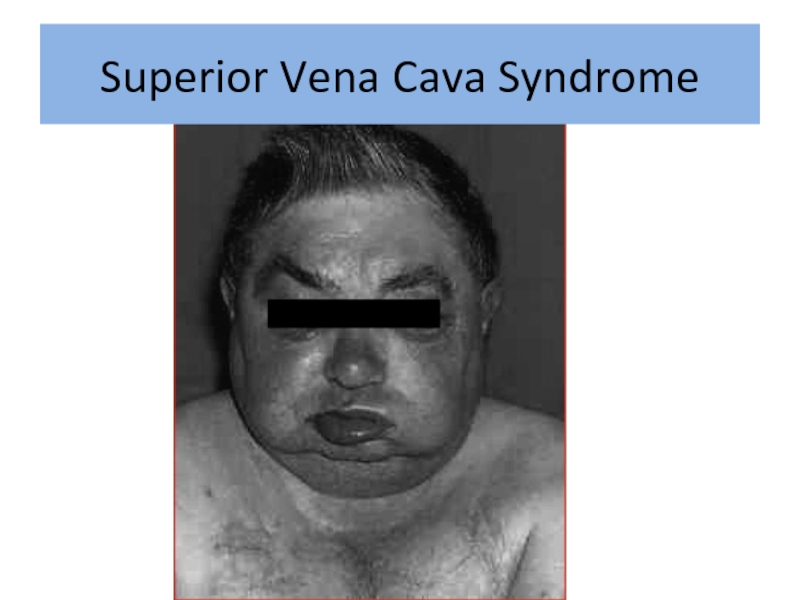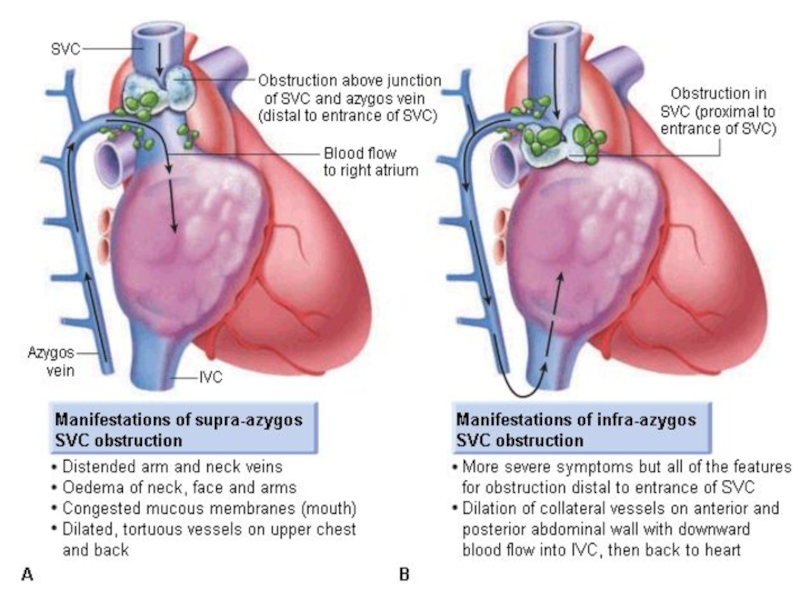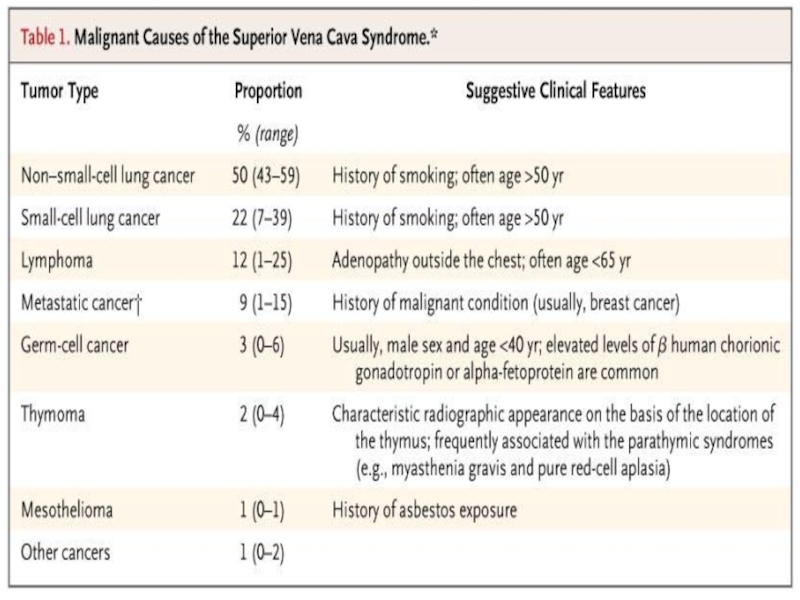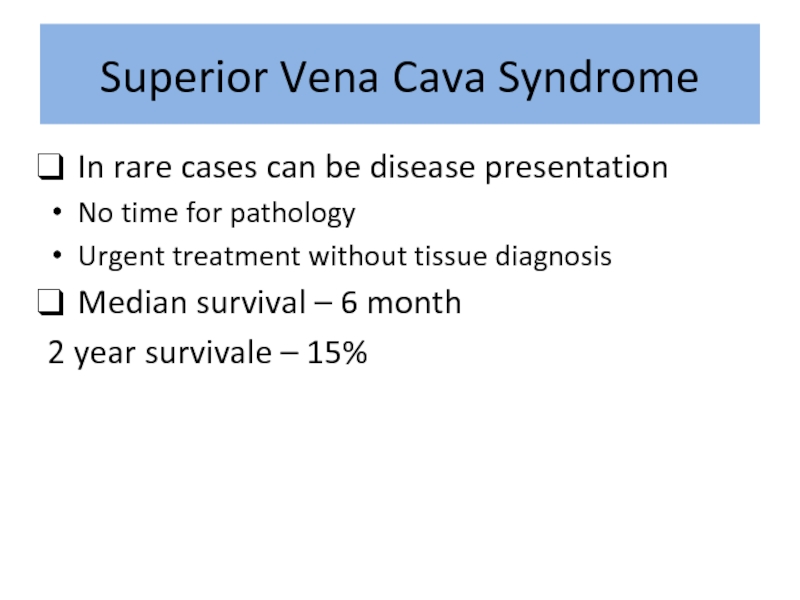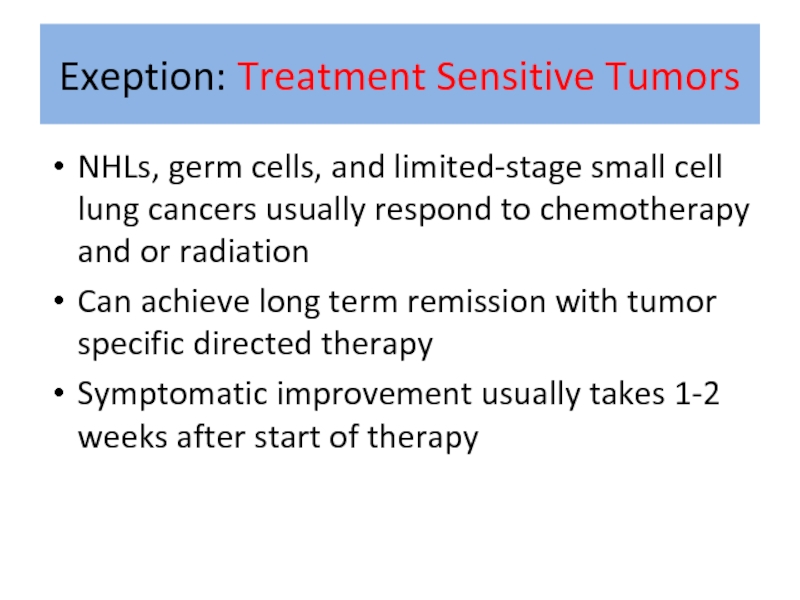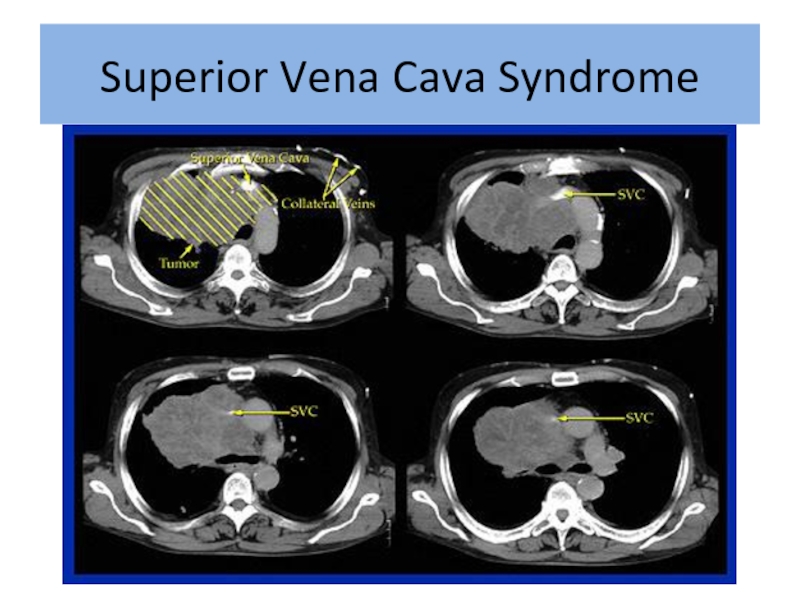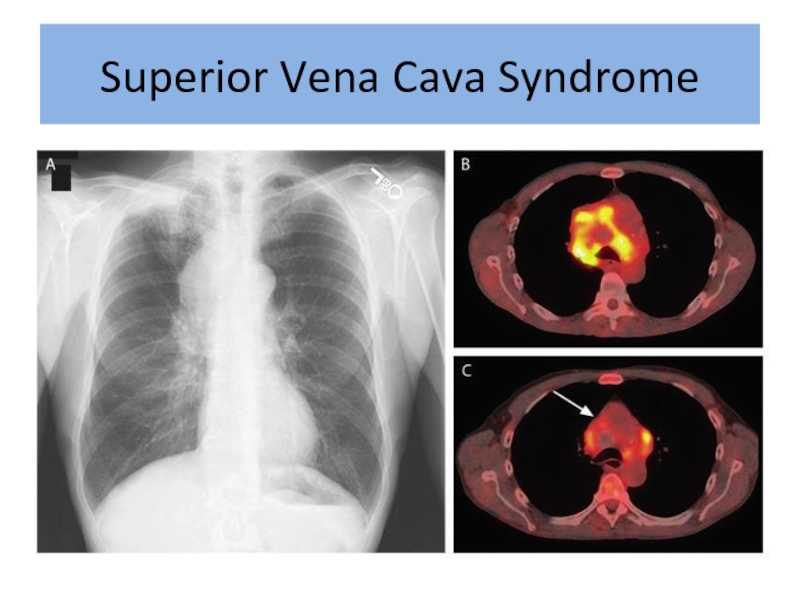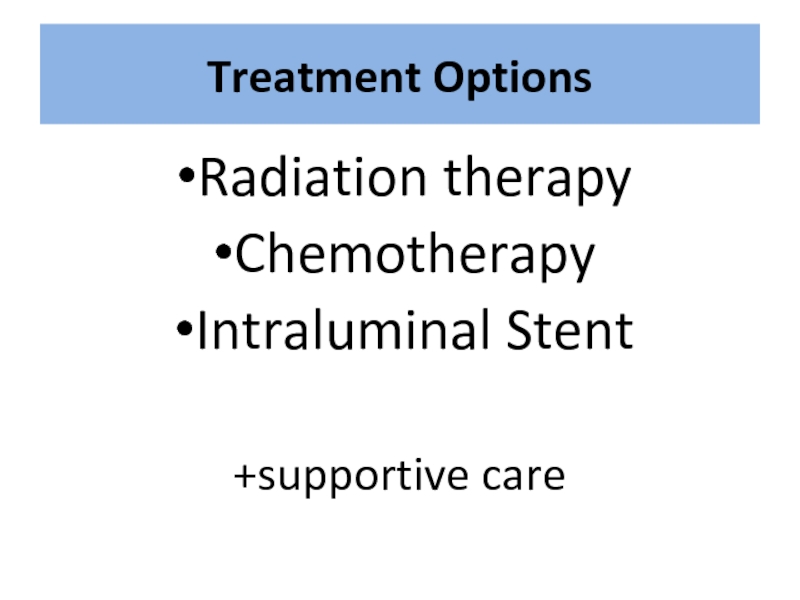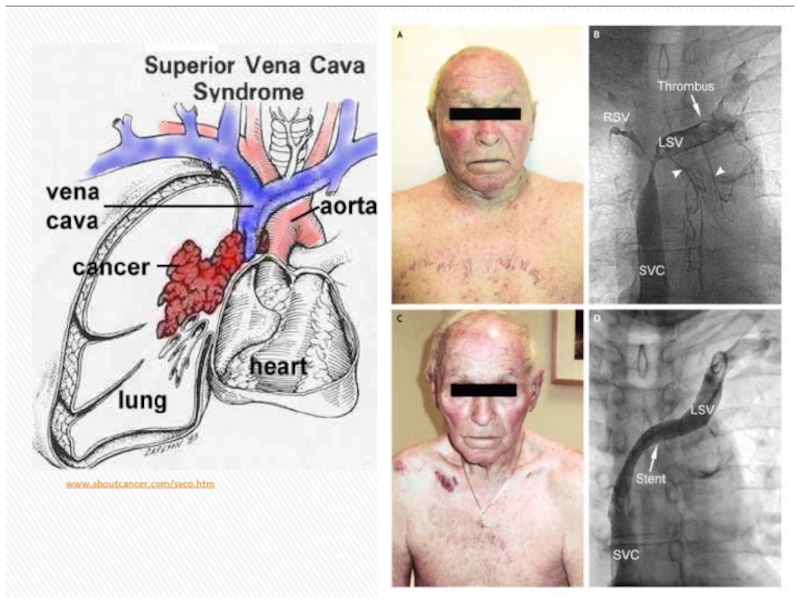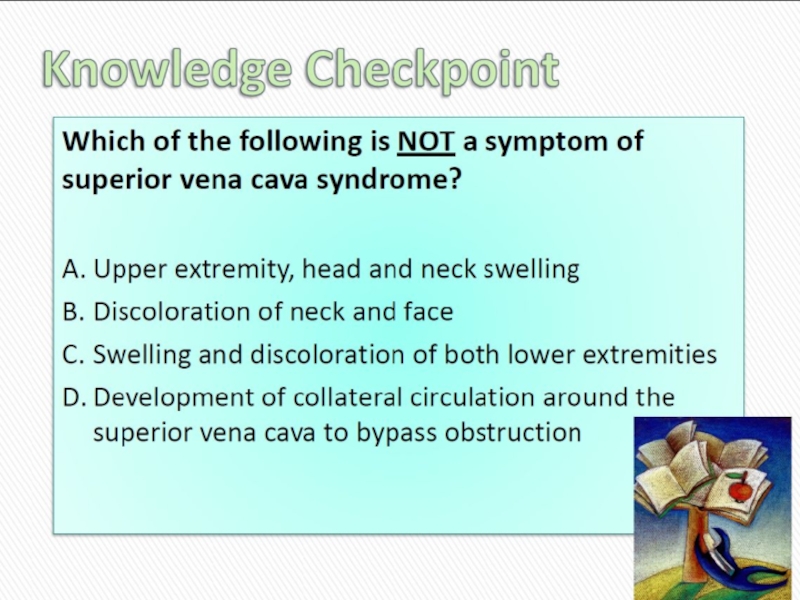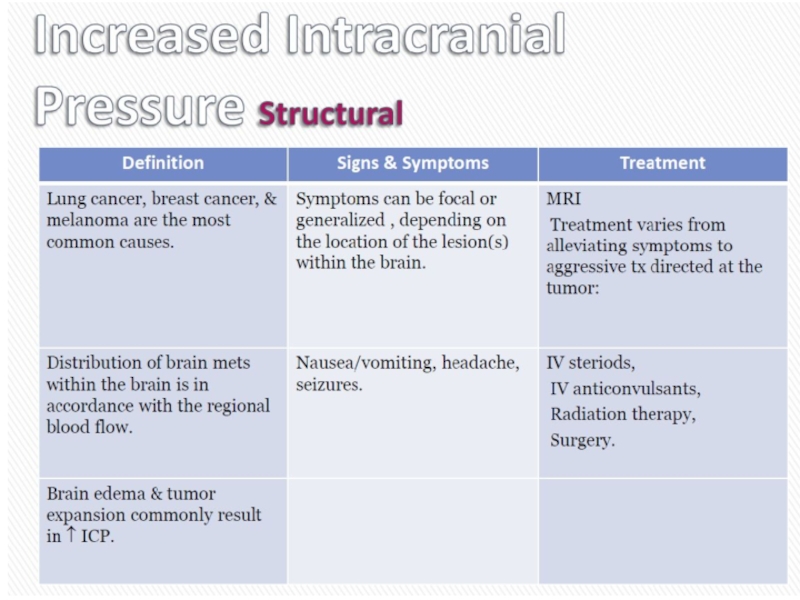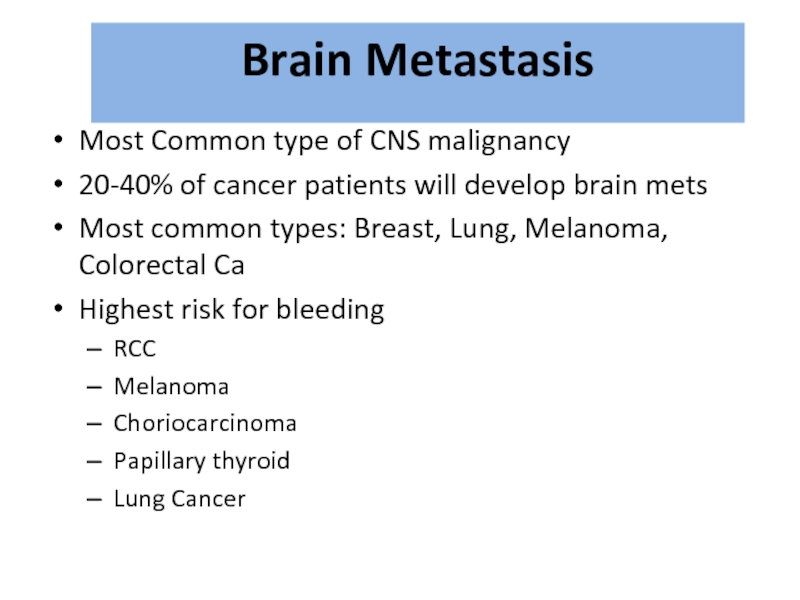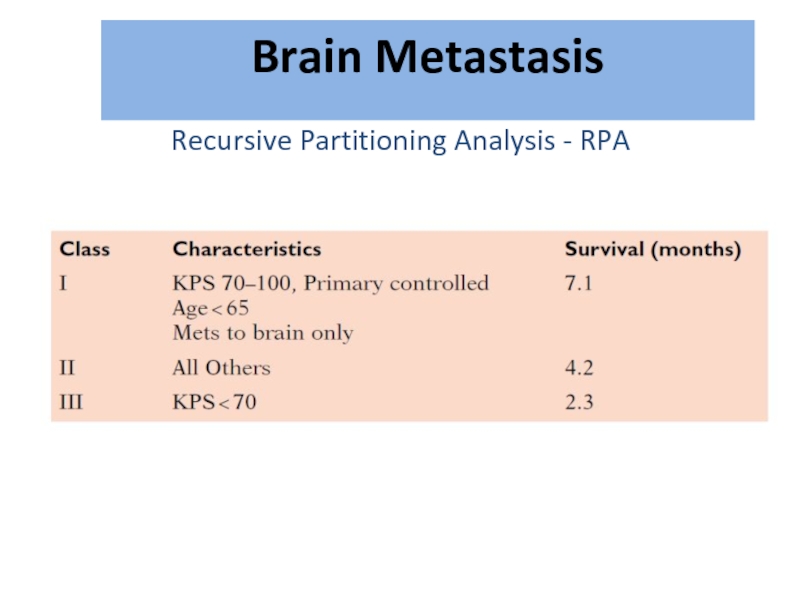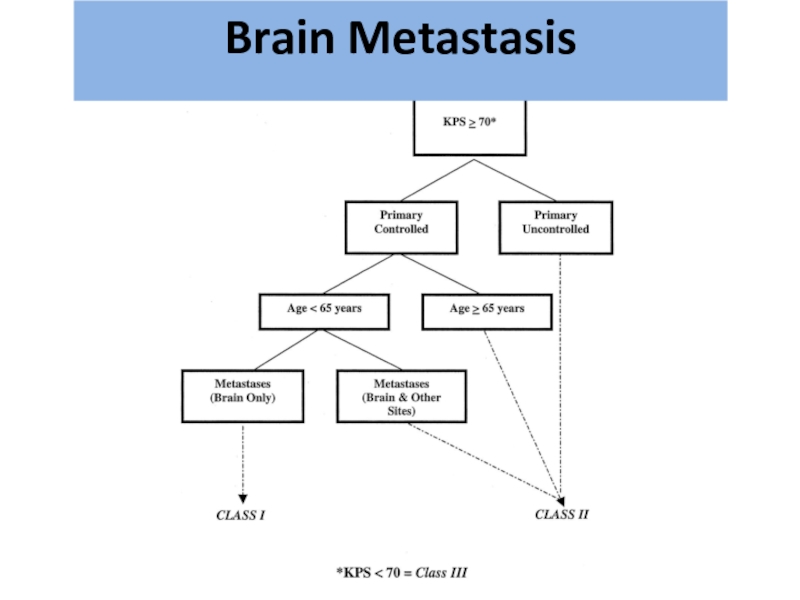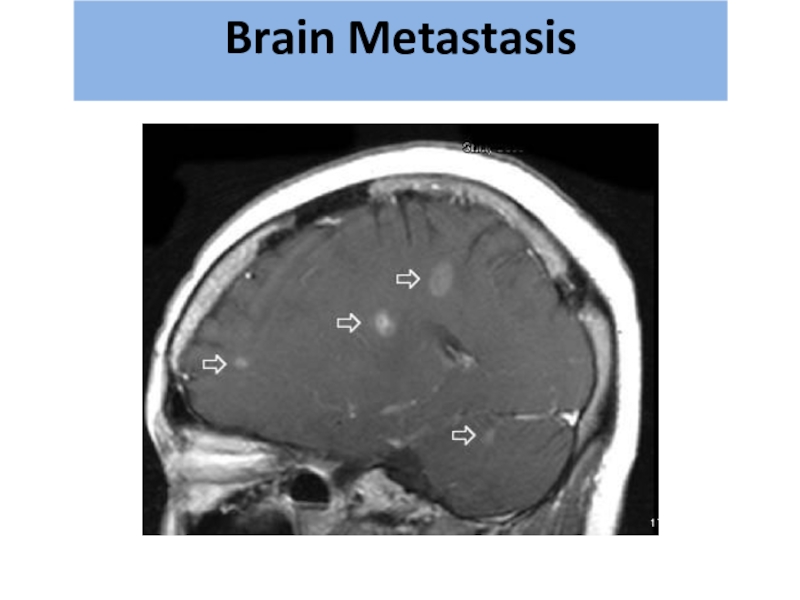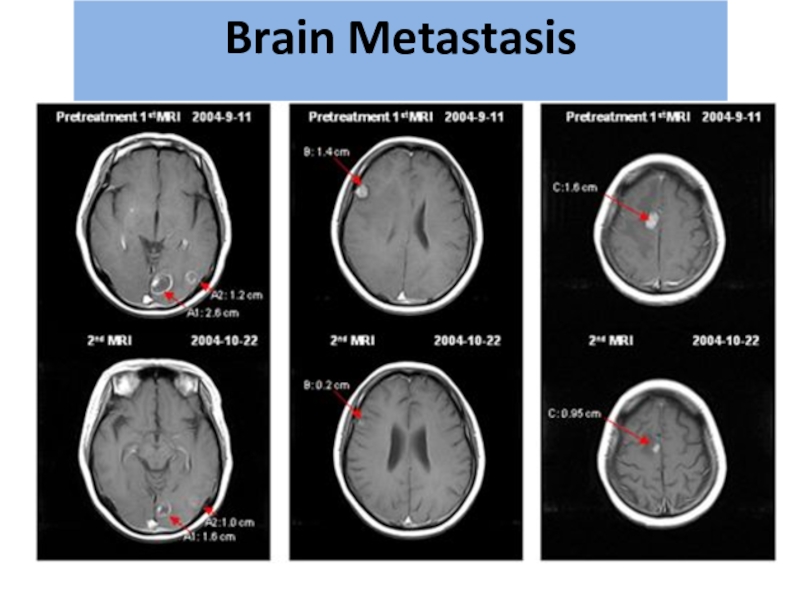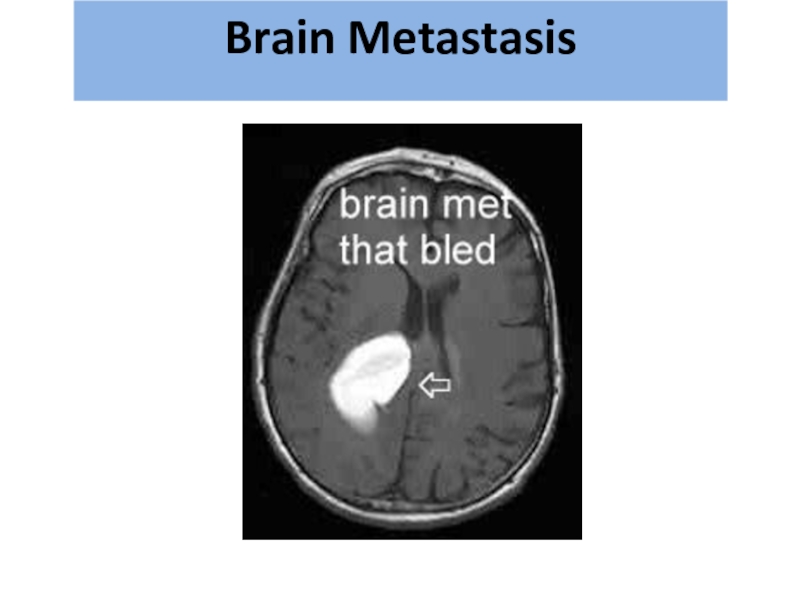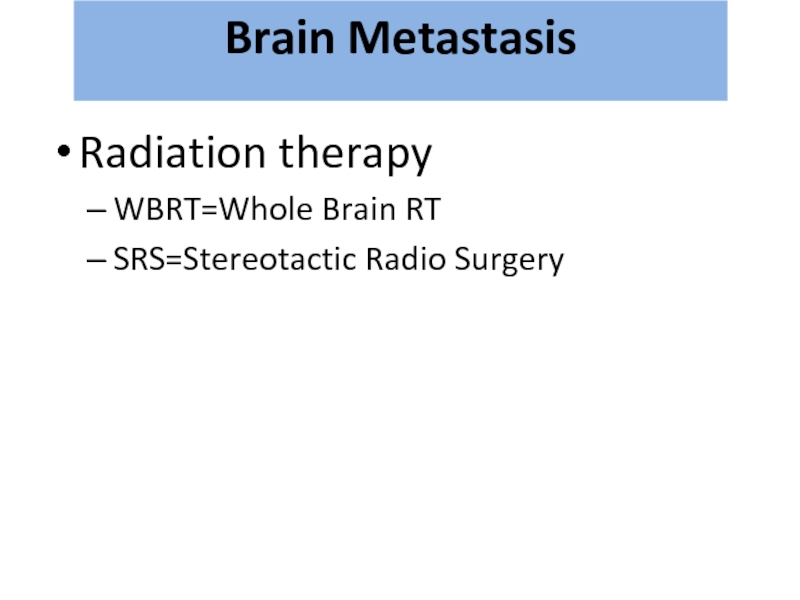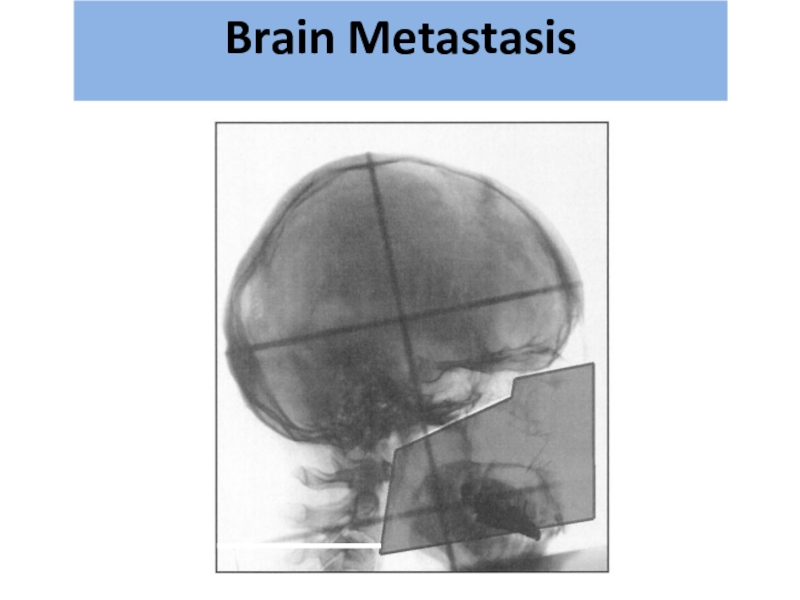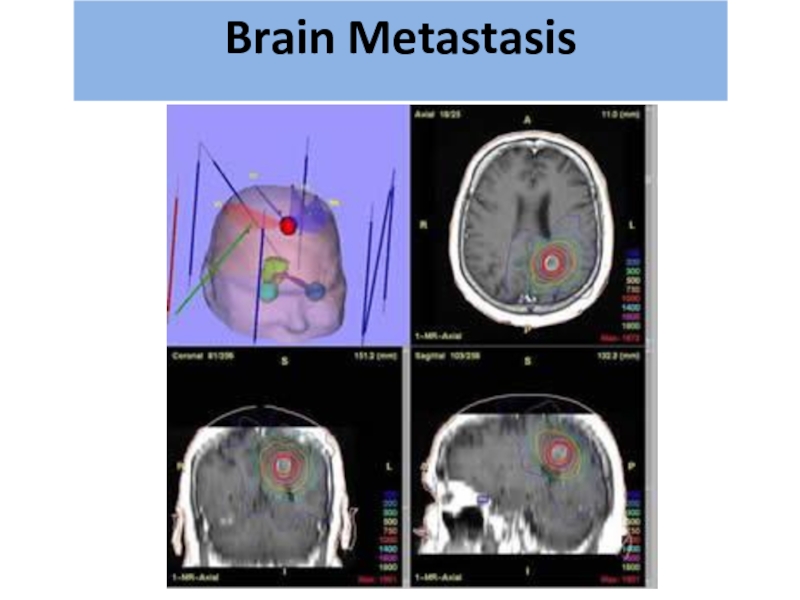- Главная
- Разное
- Дизайн
- Бизнес и предпринимательство
- Аналитика
- Образование
- Развлечения
- Красота и здоровье
- Финансы
- Государство
- Путешествия
- Спорт
- Недвижимость
- Армия
- Графика
- Культурология
- Еда и кулинария
- Лингвистика
- Английский язык
- Астрономия
- Алгебра
- Биология
- География
- Детские презентации
- Информатика
- История
- Литература
- Маркетинг
- Математика
- Медицина
- Менеджмент
- Музыка
- МХК
- Немецкий язык
- ОБЖ
- Обществознание
- Окружающий мир
- Педагогика
- Русский язык
- Технология
- Физика
- Философия
- Химия
- Шаблоны, картинки для презентаций
- Экология
- Экономика
- Юриспруденция
Oncological Emergencies презентация
Содержание
- 1. Oncological Emergencies
- 2. What is Oncologic Emergency? A clinical
- 5. METABOLIC
- 6. Hypercalcemia of Malignancy. Major Mechanisms: Local osteolytic
- 8. Symptoms GI : Nausea, vomiting, Anorexia,Constipation
- 9. Lab Total calcium & albumin or ionized
- 13. Cиндром неадекватной секреции антидиуретического гормона (SIADH)
- 15. Osmotic Demyelination Syndrome Recall that during chronic
- 18. Acute Tumor Lysis Syndrome Usually starts 6-72
- 19. Etiologic Factors Large Tumor burden High growth
- 22. Treatment Best treatment – prevention
- 23. Stop the chemotherapy Aggressive IV hydration
- 27. STRUCTURAL: Neurologic emergencies
- 28. Spinal Cord Compression
- 29. What is malignant spinal cord compression? Occurs
- 30. Most commonly seen in Breast Lung Prostate
- 31. Method of spread 85%From vertebral body or
- 32. Location Thoracic spine 60-70% Lumbosacral spine 20-30%
- 34. First Symptoms Pain 95% Weakness 5% Ataxia 1% Sensory loss 1% RED FLAGS…..
- 35. First Red Flag: Pain Usually first and
- 36. Second Red Flag: Motor Weakness: 60-85% At
- 37. Third Red Flag: Bladder & Bowel Function
- 38. Investigations & information needed prior to therapy
- 39. Treatment options include: Immobilisation Steroids & gastric
- 40. Indications for Surgery • Unknown
- 41. Surgery
- 45. Improvement in surgery + RT Days remained
- 46. Radiation Therapy
- 48. Prognosis Median survival with MSCC is 6
- 49. Superior Vena Cava Syndrome
- 51. Superior Vena Cava Syndrome
- 52. Superior Vena Cava Syndrome
- 54. Superior Vena Cava Syndrome
- 57. In rare cases can be disease presentation
- 58. Exeption: Treatment Sensitive Tumors NHLs, germ cells,
- 59. Superior Vena Cava Syndrome
- 60. Superior Vena Cava Syndrome
- 61. Superior Vena Cava Syndrome
- 62. Treatment Options Radiation therapy Chemotherapy Intraluminal Stent +supportive care
- 63. Supportive Care: Rest Head elevation
- 64. Intraluminal Stents Endovascular placement under fluoroscopy
- 66. Endovascular stenting and angioplasty Superior vena cava syndrome
- 70. Most Common type of CNS malignancy 20-40%
- 71. Recursive Partitioning Analysis - RPA גרורות מוחיות Brain Metastasis
- 72. גרורות מוחיות Brain Metastasis
- 73. Diagnosis: CT with and without contrast
- 74. גרורות מוחיות Brain Metastasis
- 75. גרורות מוחיות Brain Metastasis
- 76. גרורות מוחיות Brain Metastasis
- 77. Treatment: Steroids – Dexamethasone 16mg*2 Anticonvulsant Surgery? Radiation therapy גרורות מוחיות Brain Metastasis
- 78. Radiation therapy WBRT=Whole Brain RT SRS=Stereotactic Radio Surgery גרורות מוחיות Brain Metastasis
- 79. גרורות מוחיות German Helmet Brain Metastasis
- 80. גרורות מוחיות Brain Metastasis
- 81. גרורות מוחיות Brain Metastasis
- 82. SRS
- 83. גרורות מוחיות Brain Metastasis
- 84. Спасибо за внимание!
Слайд 2What is Oncologic Emergency?
A clinical condition resulting from a metabolic, neurologic,
Слайд 6Hypercalcemia of Malignancy.
Major Mechanisms:
Local osteolytic hypercalcemia
Osteoclastic bone resorbing cytokines
In Extensive bone
2) Humoral hypercalcemia of malignancy
Parathyroid hormone related peptide (PTHrP) secreted systemically - 80%
Слайд 8Symptoms
GI :
Nausea, vomiting, Anorexia,Constipation
Renal
Polyuria due to interference with ADH- Diabetes
Neurologic
Lethargy and fatigue ,Cognitive and behavioural changes ,Altered mental status to coma
Muscle weakness
Слайд 9Lab
Total calcium & albumin or ionized calcium
Medical emergency above 10.5 mg/dL
Phosphorus
Creatinine,
Electrolytes
50% are hypokalemic
PTH level
If elevated may be primary hyperparathyroidism (or rarely ectopic PTH production)
Слайд 15Osmotic Demyelination Syndrome
Recall that during chronic hyponatremia, osmolytes are shifted out
With rapid correction of [Na], brain cells not able to reaccumulate these osmolytes quickly enough resulting in water shift out of cells hence cell shrinkage and concentrated ion damage1
Слайд 18Acute Tumor Lysis Syndrome
Usually starts 6-72 h from initiation of chemo
Due to rapid release of cell contents into blood stream
Most common tumor cause:
Leukemias
Lymphomas
Small cell ca
Слайд 19Etiologic Factors
Large Tumor burden
High growth fraction
High pre treatment serum LDH
Preexisting renal insufficiency
Слайд 22Treatment
Best treatment – prevention
Hydration – 3L\24h, better started 24-48
Stop nephrotoxic drugs
Monitoring of electrolyte levels
Urine alkalinization Ph >7.5
Allopurinol
Слайд 23
Stop the chemotherapy
Aggressive IV hydration / diuresis
CaCl2, NaHCO3, glucose / insulin,
Rasburicase
Emergency hemodialysis
If K > 6, urate > 10, creat. > 10, or unable to tolerate diuresis
Слайд 29What is malignant spinal cord compression?
Occurs when cancer cells grow in/near
Results in swelling & reduction in the blood supply to the spinal cord & nerve roots
The symptoms are caused by the increasing pressure (compression) on the spinal cord & nerves
Слайд 30 Most commonly seen in
Breast
Lung
Prostate
Lymphoma
Myeloma
About 10% of patients with cancer overall
What types
Слайд 31Method of spread
85%From vertebral body or pedicle
10% Through intervertebral foramina (from
4% Intramedullary spread
1%(Low) Direct spread to epidural space (Batson’s plexus)
Слайд 32Location
Thoracic spine 60-70%
Lumbosacral spine 20-30%
Cervical and sacral spine less then 10%
Слайд 35First Red Flag: Pain
Usually first and most common symptom
(80-90%)
Usually precedes
Severe local back pain
Aggravated by lying down
Pain may feel like a 'band' around the chest or abdomen (radicular)
Слайд 36Second Red Flag: Motor
Weakness: 60-85%
At or above conus medularis
Extensors of the
Above the thoracic spine
Weakness from corticospinal dysfunction
Affects flexors in the lower extremities
Patients may be hyper reflexic below the lesion and have extensor plantars
Слайд 37Third Red Flag: Bladder & Bowel Function
Loss is late finding
Problems passing
may include difficulty controlling bladder function
passing very little urine
or passing none at all
Constipation or problems controlling bowels
Autonomic neuropathy presents usually as urinary retention
Rarely sole finding
Слайд 38Investigations & information needed prior to therapy
MRI scan of the whole
Can get compression at multiple levels
Knowledge of cancer type & stage
Knowledge of patient fitness
Current neurological function
Have they lost power in their legs?
Can they walk?
Do they need a catheter?
Do they have pain?
Слайд 39Treatment options include:
Immobilisation
Steroids & gastric protection
Analgesia
Surgery – decompression &
Radiotherapy
Chemotherapy e.g. lymphoma
Hormonal manipulation e.g. prostate Ca
Слайд 40
Indications for Surgery
• Unknown primary tumour
• Relapse post RT
• Progression while
• Intractable pain
Instability of spine
• Patients with a single level of cord compression who have not been totally paraplegic for longer than 48 hours
Prognosis >3 months
Слайд 45Improvement in surgery + RT
Days remained ambulatory (126 vs. 35)
Percent that
Days remained continent (142 vs. 12)
Less steroid dose, less narcotics
Trend to increase survival
Patchell, R, Tibbs, PA, Regine, WF, et al. A randomized trial of direct decompressive surgical resection in the treatment of spinal cord compression caused by metastasis (abstract). proc Am Soc Clin Oncol 2003; 22:1.
RCT comparing surgery followed by RT vs. RT alone
Слайд 48Prognosis
Median survival with MSCC is 6 months
Ambulatory patients with radiosensitive tumours
Likely to remain mobile
MSCC is a poor prognostic indicator in cancer patients
Need better detection rates
Слайд 57In rare cases can be disease presentation
No time for pathology
Urgent
Median survival – 6 month
2 year survivale – 15%
Superior Vena Cava Syndrome
Слайд 58Exeption: Treatment Sensitive Tumors
NHLs, germ cells, and limited-stage small cell lung
Can achieve long term remission with tumor specific directed therapy
Symptomatic improvement usually takes 1-2 weeks after start of therapy
Слайд 63Supportive Care:
Rest
Head elevation
Oxygen
Diuretics
Anticoagulation
Steroids
Avoid high volume fluid infusion through upper
Слайд 64Intraluminal Stents
Endovascular placement under fluoroscopy
Patients who have recurrent disease in previously
Tumors refractory chemotherapy
Patient too ill to tolerate radiation or chemotherapy
Слайд 70Most Common type of CNS malignancy
20-40% of cancer patients will develop
Most common types: Breast, Lung, Melanoma, Colorectal Ca
Highest risk for bleeding
RCC
Melanoma
Choriocarcinoma
Papillary thyroid
Lung Cancer
Brain Metastasis
Слайд 73Diagnosis:
CT with and without contrast
MRI – modality of choice for small
If no previous history of malignancy - consider total body imaging
גרורות מוחיות
Brain Metastasis


